With so many different gym benches to choose from, picking the correct size can be difficult. But it’s important to choose the right dimensions. Not only does size affect comfort, but it also dictates if the bench will fit in your home gym or not. This article will explore average weight bench dimensions to help you make the right buying decision.
On average, weight bench dimensions measure 48″ length by 19″ width by 34″ height. However, the exact size can vary depending on the bench type, brand, model, and cost. Adjustable benches are often taller than flat benches but also have a similar footprint.
My research is based on the dimensions of 12 different weight benches. It will show you how big a weight bench really should be.
During my buying phase, I was completely overwhelmed by the sheer volume of different sizes.
But this study means you don’t need to go through the same headache!
Let’s jump right in.
- Looking For A Good Weight Bench In A Hurry?
- I Sampled 12 Benches To Determine Average Dimensions
- Average Dimensions Of A Weight Bench
- Average Dimensions For An Adjustable Weight Bench
- Average Dimensions For A Flat Weight Bench
- Average Dimensions For A Folded Weight Bench
- Why Does Weight Bench Size Matter?
- How Dimensions Affect Performance
- My Weight Bench Recommendation
- Conclusion
Looking For A Good Weight Bench In A Hurry?
If you’re interested, here’s the home setup that I use and recommend!
| Bench | Brand | Description | Prime | Buy |
|---|---|---|---|---|
Top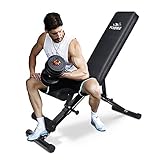 Top
Top
Top
Top
Top
Top Top
Top
Top
Top
Top
Top | Flybird | Fully-adjustable (flat/incline/decline) weight bench that can be folded for storage. Good for people 6'0 and over | PrimeEligible | Check Amazon Price |
 Top
Top
Top
Top
Top
Top Top
Top
Top
Top
Top
Top | Fitness Reality | Fully-adjustable (flat/incline/decline) weight bench that can be folded for storage. Good for people under 6'0 | PrimeEligible | Check Amazon Price |
 Top
Top
Top
Top
Top
Top
Top
Top | PowerBlock | BEST heavy adjustable dumbbell on the market. 5-90lbs (with addon kit) in 2.5lb increments make these great for building muscle and losing fat at home. Very durable. | PrimeEligible | Check Amazon Price |
 Top
Top
Top
Top
Top
Top
Top
Top | Yes4All | BUDGET alternative for a heavy adjustable dumbbell. Cheap and durable but fewer increments and slower adjustment speeds compared to the PowerBlocks | PrimeEligible | Check Amazon Price |
I Sampled 12 Benches To Determine Average Dimensions

Weight benches come in a variety of shapes and sizes.
The dimensions of a weight bench are mostly influenced by:
- Price. Expensive benches are usually bigger than cheap weight benches. This allows them to hold more weight.
- Brand. Different brands have different gym bench designs. And different designs have different lengths, widths, and heights.
- Bench type. The two main types of weight bench are adjustable and flat. Adjustable benches can adopt flat, incline, and decline angles (FID). And the adjustment mechanism can lead to larger dimensions compared to flat benches (but not always).
Therefore to find out the average weight bench sizes, it’s important to sample a variety of weight benches.
Here are the benches I’ve chosen:
| Weight Bench Type | Budget | Mid-range | Premium |
|---|---|---|---|
| Adjustable benches | Figolo bench. Linodi bench. | Flybird FB149. Fitness Reality 1000. | REP AB3000. Rogue AB3. |
| Flat benches | BalanceForm bench. Weider flat bench. | CAP flat bench. Marcy flat bench. | REP FB5000. Rogue Monster Utility 2.0. |
Why I chose this weight bench sample:
Combined, these weight benches represent a spectrum of different brands, bench types, and price points.
And sampling a broad spectrum of benches is the best way to find a reliable average.
I’ve also included the dimensions of an Olympic weight bench, for comparison’s sake (see table below).
Average Dimensions Of A Weight Bench
Here are the average dimensions of a weight bench based on 12 different benches:
| Bench | Footprint (L x W) | Bench Height | Backrest Length | Backrest Width | Seat Length | Seat Width | Seat Height | Bench Weight |
|---|---|---|---|---|---|---|---|---|
| Figolo adjustable bench | 45 x 17″ (114 x 43 cm) | 46″ 117cm | 30″ 76cm | 11″ 28cm | 12″ 30cm | 11″ 28cm | 21″ 53cm | 24lbs 11kg |
| Linodi adjustable bench | 41 x 14″ (104 x 36cm) | 42″ 107cm | 28″ 71cm | 11″ 28cm | 13″ 33cm | 14″ 36cm | 19″ 48cm | 21lbs 10kg |
| Flybird FB149 adjustable | 49 x 16″ (124 x 41cm) | 45″ 114cm | 30″ 76cm | 11″ 28cm | 13″ 33cm | 14″ 36cm | 20″ 51cm | 26lbs 12kg |
| Fitness Reality 1000 | 59 x 24″ (150 x 61 cm) | 49″ 124cm | 33.5″ 85cm | 10″ 25cm | 15″ 38cm | 15″ 38cm | 18″ 46cm | 35lbs 16kg |
| REP AB3000 adjustable | 54 x 24″ (137 x 61cm) | 52″ 132cm | 39″ 99cm | 12″ 30cm | 13″ 33cm | 13″ 33cm | 18″ 46cm | 95lbs 43kg |
| Rogue AB3 adjustable | 68 x 23″ (173 x 58cm) | 65″ 165cm | 52″ 132cm | 12″ 30cm | 12″ 30cm | 12″ 30cm | 18″ 46cm | 117lbs 53kg |
| Balance Form flat bench | 40 x 16″ (102 x 41cm) | 19″ 48cm | 40″ 102cm | 12″ 30cm | N/A | N/A | 19″ 48cm | 21lbs 10kg |
| Weider Fitness flat bench | 40″x18.5″ (102 x 41cm) | 17″ 43cm | 40″ 102cm | 11″ 28cm | N/A | N/A | 17″ 43cm | 24lbs 11kg |
| CAP Fitness flat bench | 43 x 18″ (109 x 46cm) | 19″ 48cm | 42.5″ 108cm | 14″ 36cm | N/A | N/A | 19″ 48cm | 18lbs 8kg |
| Marcy Fitness flat bench | 41 x 14″ (104 x 36cm) | 17″ 43cm | 41″ 104cm | 11″ 28cm | N/A | N/A | 17″ 43cm | 20lbs 9kg |
| REP FB5000 flat bench | 48 x 15″ (122 x 38cm) | 17″ 43cm | 48″ 122cm | 12″ 30cm | N/A | N/A | 17″ 43cm | 62lbs9 28kg |
| Rogue Monster flat bench | 47 x 26″ (119 x 66cm) | 18″ 46cm | 47″ 119cm | 12″ 30cm | N/A | N/A | 18″ 46cm | 68lbs 30kg |
| Average: | 48 x 19″ (123 x 48cm) | 34″ 86cm | 39″ 99cm | 12″ 30cm | 13″ 33cm | 13″ 33cm | 18″ 46cm | 44lbs 20kg |
| Olympic flat bench. | 48 x 50″ (123 x 127cm) | 50″ 127cm | 48″ 122cm | 12″ 30cm | N/A | N/A | 17″ 43cm | 243lbs 110kg |
Note: Seat length and width for flat weight benches are “N/A” because the backrest is the same as the seat.
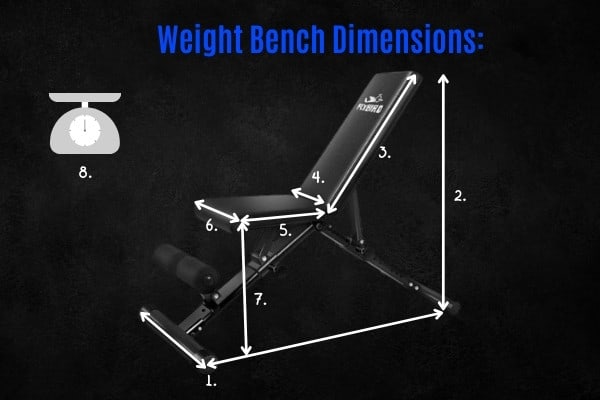
Weight bench dimensions explained:
- Footprint: how wide and long the bench is. This shows you the total footprint of the bench and how much floorspace it will require.
- Bench height: how tall the weight bench is. This shows you how much vertical space you’ll need to use the bench. Adjustable benches are taller than flat benches because the backrest can incline vertically.
- Backrest length: how long the backrest is. The backrest is separate from the seat in an adjustable bench and combined with the seat in a flat bench.
- Backrest width: how wide the backrest is. This shows you how much space the backrest padding has to accommodate your torso.
- Seat length: how long the seat is in an adjustable weight bench. This shows you how much room the seat provides for you to sit comfortably on. The seat is combined into the backrest on a flat bench.
- Seat width: how wide the seat is in an adjustable weight bench. This also shows you how much room the seat provides for you to sit on. The seat is combined into the backrest on a flat bench.
- Seat height: how tall the seat is in relation to the floor. This shows you the distance required for your legs to reach the ground when you’re sat on the bench.
- Bench weight: how many pounds the gym bench weighs. This shows you the total weight of the bench only, and does not include your body weight or free weights.
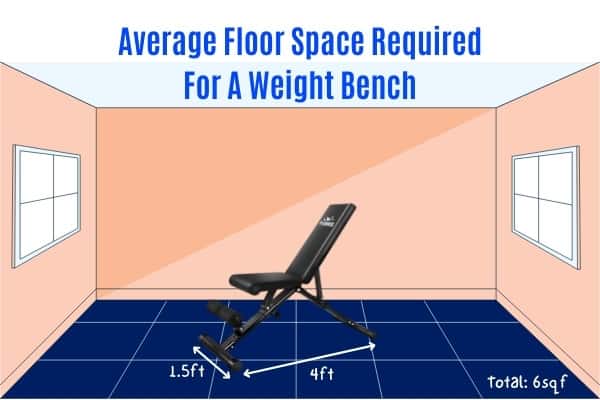
How much space is required on average for a weight bench?
On average, a weight bench requires 6 square feet of room for safe use. The average weight bench length is 4 feet, and the average width is 1.5 feet. This means the average footprint for a weight bench is 6 square feet.
Obviously, the exact room required will depend on the weight bench you choose.
In general, the more expensive the weight bench, the more space it requires.
That’s because they usually have wider dimensions that give them a greater weight capacity and stability.
Next, I’ll share the average dimensions for adjustable and flat gym benches, specifically.
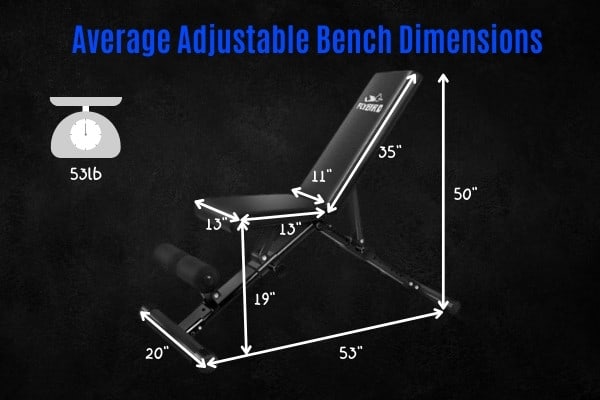
Average Dimensions For An Adjustable Weight Bench
- Length: 53″ / 135cm.
- Width: 20″ / 51cm.
- Height: 50″ / 126cm.
- Backrest length: 35″ / 89cm.
- Backrest width: 11″ / 28cm.
- Seat length: 13″ / 33cm.
- Seat width: 13″ / 33cm.
- Seat height: 19″ / 48cm.
- Bench weight: 53lbs / 24kg.
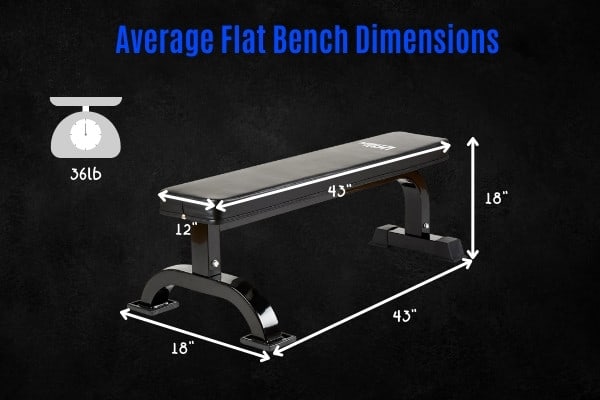
Average Dimensions For A Flat Weight Bench
- Length: 43″ / 109cm.
- Width: 18″ / 46cm.
- Height: 18″ / 46cm.
- Backrest length: 43″ / 109cm
- Backrest width: 12″ / 30cm.
- Seat height: 18″ / 45cm.
- Bench weight: 36lbs / 16kg.

Average Dimensions For A Folded Weight Bench
Foldable weight benches are quickly gaining popularity due to their great convenience.
They provide all the great benefits of a weight bench, but they also allow the user to stow it away after use.
Here are the average dimensions for a folded weight bench:
| Foldable Weight Bench | Folded Length | Folded Width | Folded Height | Space Savings Compared To Unfolded State |
|---|---|---|---|---|
| Figolo bench | 32″ 81cm | 11″ 28cm | 11″ 28cm | 87% |
| Linodi bench | 30″ 36cm | 6″ 15cm | 14″ 36cm | 90% |
| Flybird FB149 | 30″ 36cm | 9″ 23cm | 14″ 36cm | 89% |
| Flybird FB139 | 32″ 81cm | 16″ 41cm | 13″ 33cm | 76% |
| Flybird flat bench | 45″ 81cm | 12″ 30cm | 7″ 18cm | 60% |
| Fitness Reality 1000 | 59″ 114cm | 24″ 61cm | 9″ 23cm | 81% |
| PassYou bench | 35″ 90cm | 10″ 25cm | 16″ 41cm | 68% |
| Average: | 38″ 97cm | 12″ 30cm | 12″ 30cm | 78% |
Note: this selection of weight foldable weight benches is based on the most popular models at the time of writing.
You can see that the average dimensions for a folded weight bench are around 38″x12″x12″.
Furthermore, most foldable weight benches allow you to save around 78% space compared to non-foldable benches.
If you’re going to buy a foldable weight bench, it’s worth choosing one that folds more compactly!
If folding capabilities are important to you, then I highly recommend the Flybird range. They make some of the best value-for-money folding adjustable weight benches. You can check out my other article to find out which is the best Flybird bench.
Who are foldable benches good for?
Folding benches are great for beginners/intermediates to do dumbbell training at home.
Although they offer awesome space savings through their folding capabilities, they have a major drawback- a reduced weight capacity.
This is because of their folding capabilities weaken the structural support, meaning they rarely exceed more than 700-lbs of weight capacity.
Therefore folding benches are ideal for home dumbbell training where weights don’t usually exceed 180-lbs.
But if you’re an experienced lifter who regularly does 400+ pound barbell training, then these benches aren’t ideal.
I recommend you go for a fixed-adjustable bench instead.
Why Does Weight Bench Size Matter?
Here’s why it’s important to choose a weight bench with good dimensions.
- Length: this mainly applies to to adjustable benches. A longer bench means it’s less likely to rock backwards when you apply forward force with your legs. An example is during the incline bench press where you push your feet into the ground to generate maximum power. I would recommend a bench that’s at least 45″ long.
- Width: a wider base reduces the likelihood that the bench will rock left and right as you generate momentum during heavy lifting. I would recommend a bench width of at least 17″.
- Height: this mainly applies to adjustable benches. Bench height affects comfort. You want a bench that’s not too high or too low. The optimal bench height will vary depending on your body dimensions. In general, I would recommend a bench thats no shorter than 45″.
- Backrest length: this affects how well your body is supported in laying positions (e.g. during the bench press). If the backrest is too short, your upper back, neck, and head may overhang from the top. This makes for an uncomfortable lifting experience. I would recommend a backrest length no shorter than 30″.
- Backrest width: this affects how well your torso is supported by the bench. It shouldn’t be too wide or too narrow. A wide backrest can prevent your arms from achieving a free range of movement, whilst a narrow backrest may not fully accommodate your torso. A width between 11″-14″ is good.
- Seat length: this mainly applies to adjustable benches and affects comfort. A seat that’s too short means your butt may not fit comfortably. A 12″ seat length or more is good.
- Seat width: this mainly applies to adjustable benches and also affects comfort. A seat that’s too wide will force your legs apart when sat on it. This can make it difficult to maintain a firm foot-floor connection in exercises like the incline bench press. A seat width between 12″-14″ is the best for most people.
- Seat height: this mainly applies to adjustable benches. A seat that’s too high will prevent a solid foot-floor connection. But a seat that’s too low can be uncomfortable for people with long legs. The ideal seat height is between 16″-18″ (this is the official Olympic weight bench seat height).
- Bench weight: the heavier the bench the less likely it will rock and the more stable it is. I would recommend a bench weight of at least 25lbs.
- Folded dimensions: applies to foldable benches only. Smaller folded dimensions allow you to stow the bench more easily after use.
If you’re unsure about whether or not a weight bench can benefit you, my other article on the benefits of a gym bench can help you decide!
How Dimensions Affect Performance
Here’s how the differences in adjustable and flat weight bench sizes affect user experience:
1) Both types of benches have a similar footprint.
On average, adjustable and flat weight benches have a similar total footprint (around 4 feet by 1.5 feet).
This means they both require a similar amount of floor space.
A higher footprint usually indicates a more stable bench because the wider dimensions help prevent the bench from rocking over.
However, factors such as bench weight and height will also contribute to stability.
Also, cheap benches tend to have a smaller footprint compared to more expensive benches, making them more unstable.
2) Adjustable benches are taller.
On average, adjustable benches have a greater height compared to flat benches.
This is no surprise since the height of an adjustable bench mainly comes from the vertically inclining backrest.
This is something that a flat weight bench cannot do.
A higher bench usually results in lower stability since the center of gravity is raised.
However, other factors such as the length/width of the base and bench height will also contribute to the overall stability of a weight bench.
This means the height is not necessarily the best indicator for the stability of a bench.
Additionally, expensive adjustable benches are usually taller than cheap adjustable benches.
This allows them to provide the greatest amount of upper body support in exercises like the incline bench press and seated shoulder press (where you want your head and neck to be supported by the backrest).
Top tip: you don’t necessarily need a bench to train the chest. Go to my other article to find out how to do chest flyes without a bench.
3) Adjustable benches have higher seats.
On average, adjustable benches have a taller seat compared to flat benches.
This is mainly because cheap adjustable benches usually have high seats, therefore raising the average.
Cheap adjustable benches are not designed as well as expensive adjustable benches.
As a result, their FID adjustment mechanisms can cause the seat to sit higher.
In comparison, expensive adjustable benches have seat heights close to the average 17″.
Generally speaking, seat heights over 19″ should be avoided by short people since it raises your feet too far off the ground.
This can make it difficult to get a solid foot-floor plant in exercises like the bench press.
4) Adjustable benches weigh more.
On average, adjustable weight benches weigh 50% more than flat weight benches.
This is no surprise since adjustable benches require extra structural support to accommodate the FID mechanism.
In comparison, a flat weight bench can be made more stable with less structural support.
Generally speaking, expensive benches are always heavier than cheap benches.
This allows expensive benches to take more weight.
That’s because a heavier bench rocks less when you’re lifting heavy weights (like barbells).
Benches that weigh over 50lbs are ideal for heavy barbell training.
Benches that weigh between 25-50lbs are great for heavy dumbbell training and moderately heavy barbell training.
Anything lower than this will usually result in an unstable weight lifting experience.
My Weight Bench Recommendation
| Bench | Brand | Description | Prime | Buy |
|---|---|---|---|---|
Top Top
Top
Top
Top
Top
Top Top
Top
Top
Top
Top
Top | Flybird | Fully-adjustable (flat/incline/decline) weight bench that can be folded for storage. Good for people 6'0 and over | PrimeEligible | Check Amazon Price |
 Top
Top
Top
Top
Top
Top Top
Top
Top
Top
Top
Top | Fitness Reality | Fully-adjustable (flat/incline/decline) weight bench that can be folded for storage. Good for people under 6'0 | PrimeEligible | Check Amazon Price |
 Top
Top
Top
Top
Top
Top
Top
Top | PowerBlock | BEST heavy adjustable dumbbell on the market. 5-90lbs (with addon kit) in 2.5lb increments make these great for building muscle and losing fat at home. Very durable. | PrimeEligible | Check Amazon Price |
 Top
Top
Top
Top
Top
Top
Top
Top | Yes4All | BUDGET alternative for a heavy adjustable dumbbell. Cheap and durable but fewer increments and slower adjustment speeds compared to the PowerBlocks | PrimeEligible | Check Amazon Price |
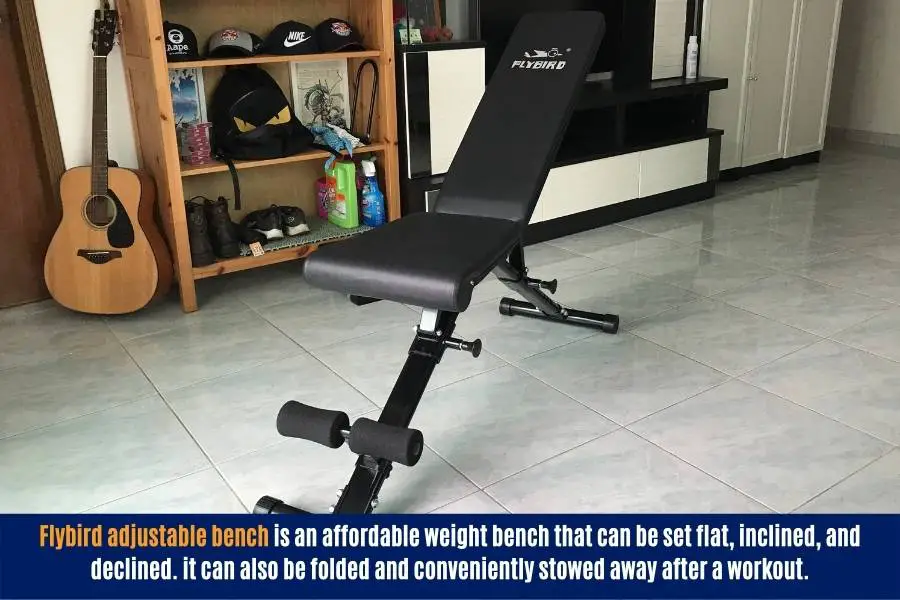
I use and recommend the Flybird foldable bench (link for the cheapest price).
Having researched more than a dozen different weight benches, I felt this bench had the best balance between a good price and comfortable dimensions.
Whilst it doesn’t give you the same quality as a commercial gym bench, it’s no slouch of a bench either.
In fact, it gives beginners-intermediates awesome value for money in my opinion.
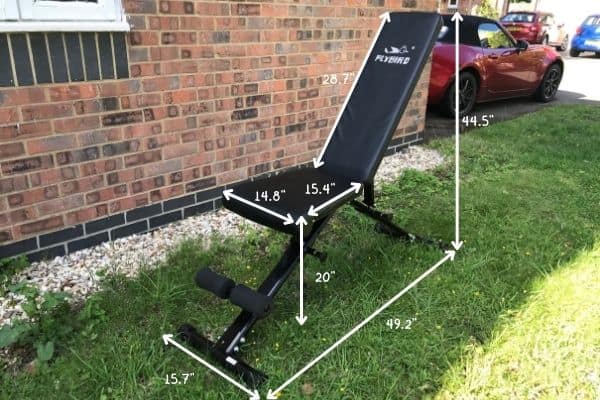
It has a wide base and weighs 26lbs, which makes it very sturdy for a beginner’s bench.
The seat and backrest are also long/wide enough for most people to find comfortable.
The best thing about the Flybird though is that it can be folded after your workout.
And its folded dimensions are very compact, allowing for easy storage.
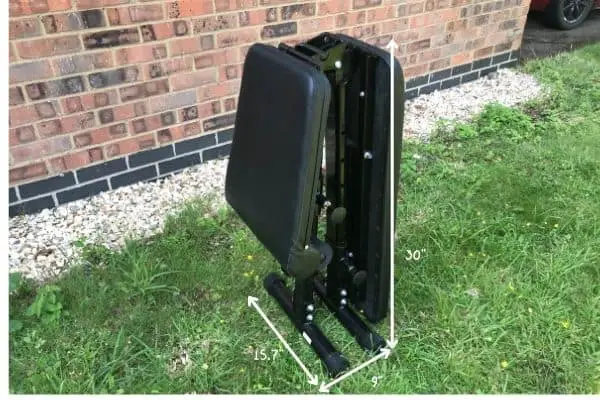
One thing to be careful about is the 20″ seat height.
20 inches can be too high for people under 5’7″.
The backrest can also be a bit short for people over 6’0″.
If you belong to these two height categories, then I’d recommend the Fitness Reality adjustable weight bench (link for cheapest price) instead.
It has a lower seat height and longer backrest compared to the Flybird.
Both benches have great dimensions for their price.
They’re both great for beginners to do dumbbell training at home.
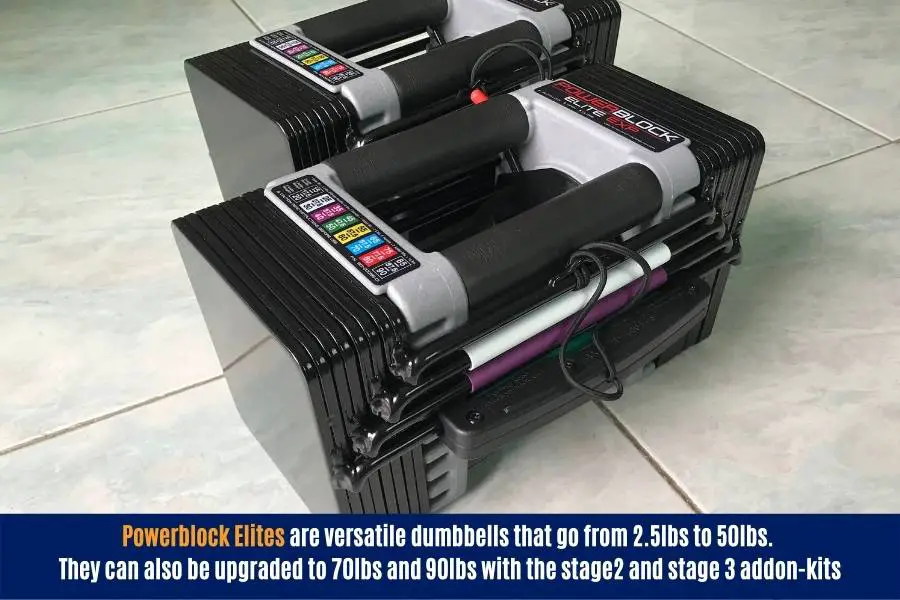
If you’re looking for heavy dumbbells that are also space-efficient, then I recommend the Powerblock Elites.
These dumbbells are pricey but will replace an entire set of dumbbells (saving you space)
They are also some of the most affordable premium heavy dumbbells you can get.
If cash is tight, then the Yes4All spinlock dumbbells make a great budget alternative.
All in all, these bench and dumbbell recommendations are a space-efficient way for beginners to build a bigger chest and gain 20lbs+ of muscle at home.
Conclusion
I’ve shared the average weight bench dimensions for adjustable and flat gym benches.
But you should be aware that dimensions vary greatly between different bench types, brands, and price points.
When you’re shopping for a bench, it’s important to consider if the dimensions for that specific bench are right for your body dimensions.
Doing so will ensure you pick a bench that performs well and is comfortable.
You should be fine if you stick as close as possible to the average bench dimensions and follow my recommendations!
Which of my bench examples do you think has the best dimensions for you?
Let me know in the comments!
Thanks for reading guys!
Peace Out,
Kal
(Biochemistry BSc, Biomedical Sciences MSc, Ex-Skinny Guy)

